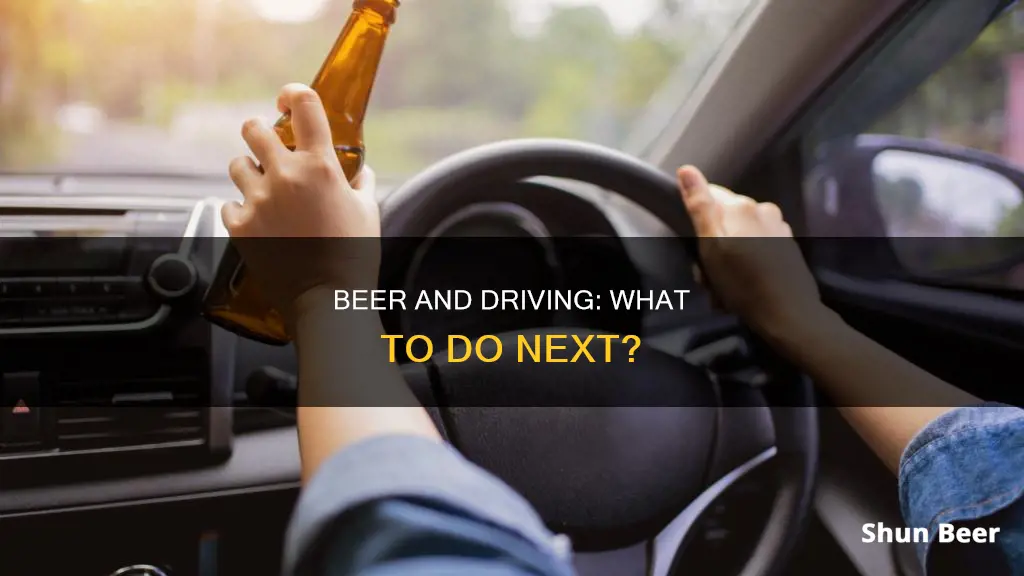
Drinking and driving is a serious offense with potentially severe consequences. Even a single alcoholic beverage can impair your judgment, slow your reaction time, and make it difficult to focus on the road, increasing the risk of accidents and legal repercussions. The safest option is to refrain from drinking entirely if you plan to drive. However, if you have consumed alcohol, understanding the factors influencing intoxication and waiting an adequate amount of time before driving is crucial. The rate at which alcohol is metabolized varies between individuals, and factors such as age, weight, biological sex, food intake, and health conditions play a role. While there is no definitive formula, the general guideline is to allow at least one hour per standard drink for your body to process the alcohol. It's important to remember that drinking coffee, taking a cold shower, or relying on similar methods will not expedite sobriety. The only way to ensure a safe blood alcohol level for driving is to allow sufficient time for your body to eliminate the alcohol naturally.
| Characteristics | Values |
|---|---|
| What to do after drinking and before driving | Wait for at least one hour per drink consumed. However, there is no safe amount of alcohol that can be consumed before driving. |
| Factors affecting Blood Alcohol Concentration (BAC) | Amount of alcohol consumed, time period over which alcohol was consumed, age, weight, height, regularity of drinking, food consumption, medications, and other substances. |
| Effects of alcohol on driving | Impaired judgement, slower reaction time, difficulty focusing, reduced coordination, and inability to control speed. |
| Legal alcohol limit | 0.08 grams of alcohol per deciliter (g/dL) or higher in the United States. |
What You'll Learn

The dangers of drinking and driving
Drinking and driving is a serious issue that can lead to dangerous consequences. Here are some key dangers to be aware of:
Impaired Judgement and Decision-Making
Alcohol can significantly impair your judgement and decision-making abilities. This can lead to making risky choices, such as choosing to drive when you are intoxicated. Alcohol can also make it harder to focus on the road and increase your susceptibility to distractions, such as texting or using your phone.
Slower Reaction Time and Lack of Coordination
Alcohol slows down your reaction time, making it more difficult to respond quickly to sudden changes on the road, such as a car braking in front of you or a pedestrian crossing the street. Additionally, alcohol impairs your motor skills, including eye, hand, and foot coordination, which are crucial for safe driving.
Reduced Concentration and Increased Likelihood of Accidents
Even a small amount of alcohol can impact your concentration, which is essential for safe driving. Driving requires constant attention to multiple factors, such as speed, lane positioning, other vehicles, and traffic signals. Alcohol reduces your attention span and increases the chances of an accident.
Vision Impairment
Excessive alcohol consumption can negatively affect your vision, causing blurred vision, uncontrolled eye movement, or even partial loss of control over eye movement. This can impair your ability to judge distances accurately and reduce your peripheral vision, making it more challenging to drive safely.
Legal Consequences
Drinking and driving can result in serious legal repercussions. If you are caught driving under the influence, you may be charged with a DUI (Driving Under the Influence) or DWI (Driving While Intoxicated). This can lead to fines, jail time, loss of your driver's license, probation, and increased insurance rates. In some cases, you may be required to install an ignition interlock device in your vehicle or participate in alcohol treatment programs.
Beer and Whiskey: Mixing Alcohol Safely
You may want to see also

The legal blood alcohol concentration limit
Drinking and driving is a serious offence with long-lasting repercussions. Even if you don't feel the effects of alcohol, your blood alcohol content (BAC) may exceed your state's legal limit. The legal blood alcohol concentration (BAC) limit in the United States is .08 grams of alcohol per decilitre (g/dL). However, this limit is not uniform across the world, with many European countries adopting a lower limit of .05 g/dL.
In the US, a BAC of .08 g/dL or higher is considered DUI per se, meaning you are presumed to be too intoxicated to drive. This means that if you are stopped by the police and found to have a BAC above the legal limit, you can be charged with a drunk driving offence, even if you do not appear to be impaired. The prosecutor does not need to provide any additional evidence of impairment to secure a conviction.
It is important to note that alcohol affects everyone differently, and your BAC can depend on various factors such as age, weight, biological sex, and the amount and speed of consumption. Additionally, the effects of alcohol on driving ability, such as impaired judgement and slower reaction times, can occur even when you are below the legal limit. As such, it is always best to avoid drinking after consuming alcohol altogether and to make alternative arrangements for transportation.
The consequences of driving under the influence can be severe, including steep fines, jail time, and the requirement to install an ignition interlock device in your vehicle. Furthermore, a DUI conviction can have long-lasting impacts on your life, affecting your ability to get a job, housing, or student loans. Therefore, it is crucial to understand the legal BAC limit and make informed decisions about drinking and driving to ensure your safety and compliance with the law.
Beer and Sleep: Enemies or Friends?
You may want to see also

How alcohol affects your driving ability
Drinking alcohol and driving is a dangerous combination that can lead to serious accidents and legal repercussions. Alcohol is a depressant drug that slows down the central nervous system, including the brain, impairing your driving ability in several ways. Here are some key ways in which alcohol affects your driving skills and abilities:
Impaired Judgement and Increased Risk-Taking
Alcohol can alter your judgement and make it difficult to think clearly, make good decisions, and plan ahead. It can also lead to increased risk-taking behaviours, which is dangerous when operating a vehicle.
Slower Reaction Time
Alcohol significantly slows down your reaction time, making it harder to react appropriately to hazards or obstacles on the road. This reduction in reaction time increases the risk of accidents.
Reduced Concentration and Vigilance
Alcohol affects your ability to focus and concentrate on driving tasks, such as steering, maintaining speed, staying in your lane, and avoiding other vehicles. It can also cause drowsiness, leading to a risk of falling asleep at the wheel.
Loss of Coordination and Impaired Vision
Alcohol impairs your motor skills, slowing down reflexes and reducing your ability to safely steer, use pedals, and control the vehicle. It also relaxes the muscles that control the eyes, causing blurred vision and slower visual reaction time. Peripheral vision decreases, making it difficult to see anything that isn't directly in front of you.
Difficulty Multitasking and Understanding Surroundings
Driving often involves multitasking, such as keeping in your lane while also monitoring other traffic and road conditions. Alcohol consumption can impair your ability to perform multiple tasks simultaneously. It can also make it difficult to understand what's happening around you, further increasing the risk of accidents.
Overconfidence and Failure to Obey Road Rules
Alcohol can lead to overconfidence, which may result in risk-taking behaviour. It can also impair your ability to obey road rules, increasing the likelihood of dangerous driving and accidents.
Higher Blood Alcohol Concentration (BAC)
The more you drink, the higher your BAC becomes. A higher BAC impairs your ability to perform tasks that require concentration, such as driving. Additionally, as your BAC increases, it becomes harder to accurately judge how intoxicated you are.
In summary, alcohol consumption has significant negative effects on your driving ability, impairing your judgement, slowing your reactions, reducing your coordination, and impairing your vision and concentration. The safest option is to avoid drinking altogether if you plan to drive or to arrange alternative transportation if you intend to consume alcohol. There is no safe BAC level for driving, and the more you drink, the higher the risk of accidents becomes.
Beer and Breastfeeding: What's Safe?
You may want to see also

How long it takes to sober up
It is important to note that drinking and driving do not mix. The safest thing to do is not get behind the wheel after drinking. If you've been drinking, the answer to whether you can drive is no.
There is no universal answer to how long it takes to sober up, as it depends on several factors. These factors include the amount of alcohol consumed, the rate at which it was consumed, the alcohol content, the presence of food in the stomach, medications being used, sex, body weight, and liver function.
On average, it takes the body about two hours to metabolize one standard drink. However, this can vary depending on the individual and the circumstances. The more drinks consumed, the longer it will take for the body to process the alcohol. For example, if you consume eight beers in a three-hour period, it would take approximately 13 hours to sober up.
According to the National Institute on Alcohol, it is recommended to wait at least one hour for each standard drink before driving. A standard drink is typically defined as 12 ounces of regular beer, 5 ounces of wine, or 1.5 ounces of distilled spirits. However, this is just a general guideline, and other factors can affect your blood alcohol level.
While there are some methods that can help increase alertness, such as caffeine, cold showers, and exercise, they do not actually eliminate alcohol from the blood or lower blood alcohol concentration (BAC). The only way to sober up is to give your liver time to metabolize the alcohol.
Beer Drinking: What You Need to Know
You may want to see also

What to do if you see someone drinking and driving
Drinking and driving is a serious issue that can lead to accidents, injuries, and even fatalities. If you witness someone drinking and driving, here are some steps you can take to address the situation:
- Stay Calm and Be Non-Confrontational: It's important to remain calm and approach the situation in a non-confrontational manner. Avoid raising your voice, embarrassing, or belittling the person. Instead, speak firmly and calmly, expressing your concern for their safety and that of others.
- Offer Alternatives: Suggest alternative ways for them to reach their destination, such as offering a ride, calling a cab or rideshare, or recommending public transportation. If you know the person well, suggest that they stay over or join you for a cup of coffee until they sober up.
- Enlist Help: If possible, enlist the support of others nearby, such as friends or staff at the establishment. It can be more challenging for the impaired person to refuse multiple people. If the person is a friend, you can also ask them to give you their keys before they start drinking.
- Contact Authorities: If the person insists on driving, do not attempt to stop them physically or follow them in your vehicle. Instead, contact local law enforcement or emergency services (such as 911 in the US or 999 in the UK) and provide as many details as possible about the vehicle, including the license plate number, make, model, color, and any distinguishing features. Also, note the location, street name, direction of travel, and nearby landmarks or intersections.
- Prioritize Your Safety: Remember to prioritize your safety first. If you feel unsafe approaching the person or are unable to prevent them from driving, focus on gathering information and contacting the authorities. Do not put yourself at risk by attempting to stop them physically or chasing them down.
Drinking and driving is a dangerous and preventable issue. By taking these steps, you can help keep impaired drivers off the road and potentially save lives.
Beer and Brilinta: What You Need to Know
You may want to see also
Frequently asked questions
The safest thing to do is to not get behind the wheel after drinking. If you can, call a friend, use a rideshare, or take a taxi. If you need to drive the morning after drinking, be aware that you could still have high levels of alcohol in your system, so it's best to avoid drinking altogether if you know you'll need to drive.
There is no magic formula to calculate how long you need to wait after drinking before driving, and there is no safe amount of alcohol that you can consume without being impaired. The National Institute on Alcohol recommends waiting at least one hour per drink. However, this is just a general rule of thumb, and other factors, such as weight, age, biological sex, and food intake, can affect how long it takes for your body to process alcohol.
There is no reliable way to test if you're sober enough to drive, and alcohol affects everyone differently. Even if you feel fine, your driving skills can still be impaired, and you could be charged with a DUI or DWAI even if you are under the legal blood alcohol concentration (BAC) limit.
No, there is no way to speed up how long it takes for your body to process alcohol. Drinking coffee, taking a cold shower, or using other "remedies" will not help to lower your BAC. The only thing that lowers your BAC is time.







